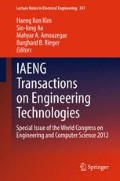Abstract
In the dynamic domain, agents often operate in the terrain which is only incompletely known and can be dynamically updated on the fly. In this case, dynamic navigation algorithm, which is required to find out an optimal solution to its goal, has been an important component in planning. However, under the environments where time is more critical than optimality, a sub-optimal solution is required. Therefore the challenge for practical applications is to find a high sub-optimal solution in limited time. The dynamic algorithm Anytime D*(AD*) is currently the best anytime algorithm which aims to return a high sub-optimal solution with short corresponding time and control of sub-optimality. In this chapter, a new algorithm named Improved Anytime D*(IAD*) is introduced. By reducing the search space, experiment results show IAD* better outperforms Anytime D* in various random benchmarks.
Access this chapter
Tax calculation will be finalised at checkout
Purchases are for personal use only
References
Davis HW, Bramanti-Gregor A, Wang J (1988) The advantages of using depth and breadth components in heuristic search. Methodol Intell Syst 3:19–28
Hansen EA, Zhou R (2007) Anytime heuristic search. J Artif Intell Res 28:267–297
Harris L (1974) The heuristic search under conditions of error. Artif Intell 5(3):217–234
Koenig S, Likhachev M (2002) D*lite. In: Eighteenth national conference on, artificial intelligence, pp 476–483
S. Koenig, Likhachev M (2002) Improved fast replanning for robot navigation in unknown, Terrain, pp 968–975
Koenig S, Likhachev M (2002) Incremental a*. Advances in neural information processing systems, pp 1539–1546
Koenig S, Likhachev M, Furcy D (2004) Lifelong planning a*. Artif Intell J 155(1–2):93–146
Korf R (1993) Linear-space best-first search. Artif Intell 62(1):41–78
Likhachev M, Ferguson D, Gordon G, Stentz A, Thrun S (2005) Anytime dynamic a*: an anytime, replanning algorithm. In: Proceedings of the international conference on automated planning and scheduling
Likhachev M, Gordon G, Thrun S (2003) Ara*: anytime a* with provable bounds on sub-optimality. Adv Neural Inf Process Syst
Pohl I (1970) Heuristic search viewed as path finding in a graph. Artif Intell 1(3):193–204
Stentz A (1995) The focussed d* algorithm for real-time replanning. In: Proceedings of the international joint conference on, artificial intelligence, pp 1652–1659
Stentz A (1997) Optimal and efficient path planning for partially-known environments, vol 388. The Kluwer international series in engineering and computer science, pp 203–220
Thayer JT, Ruml W (2008) Faster than weighted a*: an optimal approach to bounded suboptimal search. In: Proceedings of the international conference on automated planning and scheduling
Yue W, Franco J (2009) Avoiding unnecessary calculations in robot navigation. In: Proceedings of world congress on engineering and computer science, pp 718–723
Yue W, Franco J (2010) A new way to reduce computing in navigation algorithm. J Eng Lett 18(4):\(\text{ EL }\_\text{18 }\_\text{4 }\_\text{03 }\)
Yue W, Franco J, Cao W, Han Q (2012) A new anytime dynamic navigation algorithm. In: Proceedings of the world congress on engineering and computer science 2012, WCECS 2012, vol 1, pp 17–22, San Francisco, USA, 24–26 Oct 2012
Yue W, Franco J, Cao W, Yue H (2011) Id* lite: improved d* lite algorithm. In: Proceedings of 26th symposium on applied, computing, pp 1364–1369
Zhou R, Hansen E (2002) Multiple sequence alignment using anytime a*. In: Proceedings of conference on articial, intelligence, pp 975–976
Acknowledgments
This work was supported by University Research Council’s (URC), 2012 Summer Graduate Student Research Fellowships funded by University of Cincinnati.
Author information
Authors and Affiliations
Corresponding author
Editor information
Editors and Affiliations
Rights and permissions
Copyright information
© 2014 Springer Science+Business Media Dordrecht
About this chapter
Cite this chapter
Yue, W., Franco, J., Han, Q., Cao, W. (2014). Improved Anytime D* Algorithm. In: Kim, H., Ao, SI., Amouzegar, M., Rieger, B. (eds) IAENG Transactions on Engineering Technologies. Lecture Notes in Electrical Engineering, vol 247. Springer, Dordrecht. https://doi.org/10.1007/978-94-007-6818-5_27
Download citation
DOI: https://doi.org/10.1007/978-94-007-6818-5_27
Published:
Publisher Name: Springer, Dordrecht
Print ISBN: 978-94-007-6817-8
Online ISBN: 978-94-007-6818-5
eBook Packages: EngineeringEngineering (R0)

